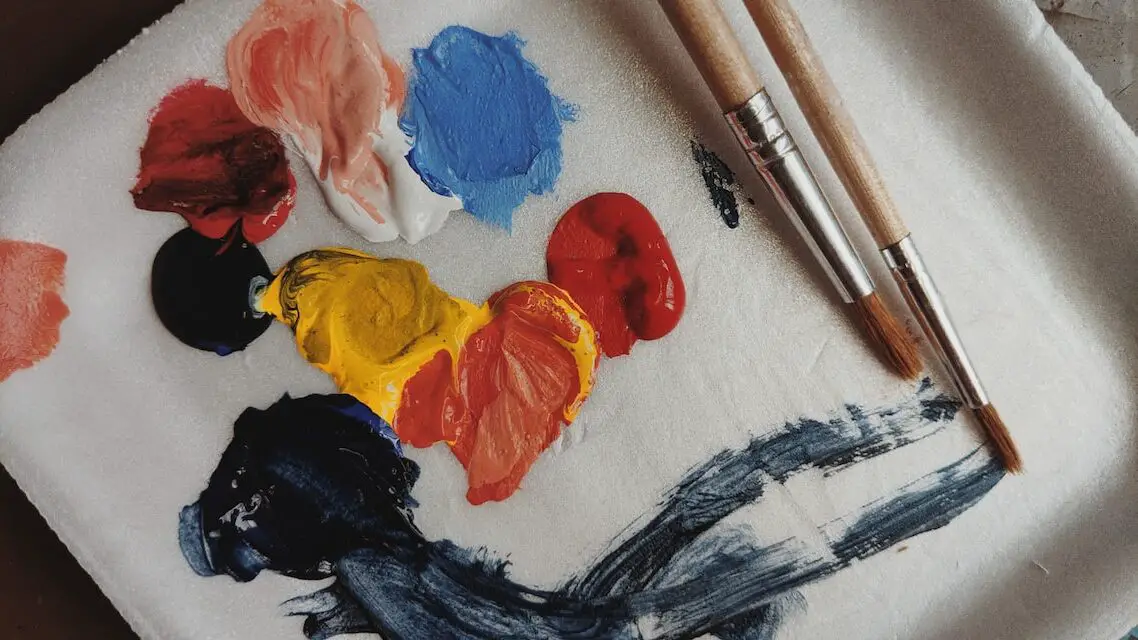You might have got new acrylic paint and it may feel too thick. Also, may have found find that some of your old acrylic paints are thicker and chunkier. The thick consistency is usually harder to paint with unless you are doing an impasto-style painting. So why has acrylic paint become too thick?
Acrylic paint becomes thicker when it is exposed to drastic temperature changes, either too hot or too cold. Also, different acrylic paints are made with different consistencies intentionally, heavy body acrylic paint being the thickest. They can be thinned using water or acrylic mediums.
Thick acrylic paint is not a bad thing unless your paint has gone bad and it all become dry. Thicker acrylic paint can hold your brush marks better and make textures. If that is not your preference you can even thin out acrylic paint with water or many different acrylic mediums available.
Why is acrylic paint too thick?
Acrylic paint can become thick for many reasons. The paint might either be a heavy body acrylic paint or it may have become thick due to temperature fluctuations, air exposure, or other similar reasons. In any case, if your paint is still wet and moist you can make it the right consistency for you.
Different thicknesses of acrylic paint…
To know why your acrylic paint is thick, you need to know the different viscosities or thicknesses of acrylic paint. As an example, Golden acrylics come in four consistencies which are heavy body, fluid, high flow, and soft body/ OPEN acrylic.
The thickest of these are heavy body acrylics, yet Golden acrylic paints are known to be of a smooth and buttery consistency. Liquitex also has a heavy body acrylic paint in their, professional acrylic range. It is said to have the thickness of oil paint and hold brushmarks well.
The OPEN acrylic paint, which is the slow-drying acrylic paint of Golden has a softer consistency than the heavy body acrylics. Also, there are Golden paint fluid acrylics that are very flowing. Liquitex has smooth body acrylic paint in their professional acrylic paint range. These have a flowing nature and a mid-viscosity.
High-flow acrylics are even flowier and ink-like. It is a very thin paint and it is the thinnest acrylic paint in consistency. Yet it is a very versatile acrylic paint. Liquitex also has acrylic ink in their professional acrylic range. It is also very flowy and ink-like.
Heavy body acrylics have the thickest consistency
So, if you have got heavy body acrylic paint, it is the thickest acrylic paint of all. You can find heavy body acrylic paint in a professional acrylic range of different brands. You can find this information on the paint tube label.
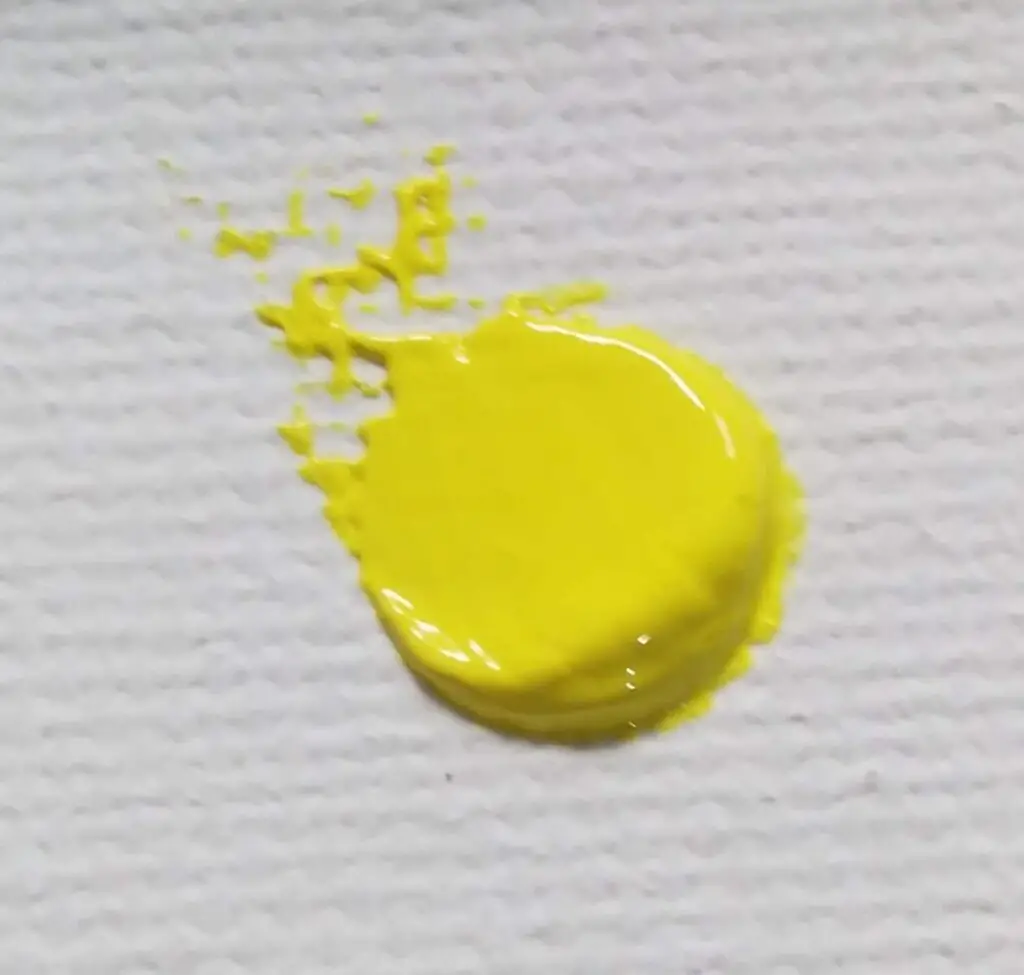
However, if you are getting a student-grade acrylic paint, you will mostly get medium body viscosity acrylics. These are less thicker than heavy body acrylic paint. Craft quality acrylic paint usually has the consistency of soft body acrylic paint, or it may also have a creamy consistency. In either case, craft-quality acrylic paint has less viscosity/ thickness than heavy body acrylic paints.
No matter what the consistency or the viscosity of acrylic paint is, if it is subjected to drastic temperature fluctuations, or loss of moisture acrylic paint can become thicker. In most cases, you can revive the acrylic paints but in other cases, it is best to toss out the acrylic paint.
Hot temperatures can make acrylic paint thicker
Temperature fluctuations can change the qualities of acrylic paint. Extreme high temperatures can make your acrylic paints all chunky and unusable. You may recognize these chunky hard paints as thick acrylic paint. This usually happens when you exposed acrylic paint to temperatures higher than 90oF (32oC) continuously.
Keep acrylic paints for a long time inside the car, also expose paints to high temperatures, as the temperature of a car become too high. Also if you are painting outside in a sunny and breezy environment this can happen. So keep an eye on your paints always and avoid these extreme temperature situations.

I have written a whole article about why acrylic paint becomes lumpy or chunky and the best methods to prevent or fix it. You will find more ways of reviving chunky, hard acrylic paints there,
Freezing temperatures can separate acrylic paint
If you subject acrylic paint to freezing temperatures continuously, it can separate and become thicker. Usually, if you kept acrylic paints below 49° F (9° C), it can separate the paint solids from the acrylic polymer binder. You can recognize acrylic paint separation if there is a clear liquid on top of acrylic paint solids.
However, according to Golden paints, their acrylic paints are formulated to withstand five freeze/thaw cycles. But they are not guaranteeing the acrylic paint stability beyond these five freeze/thaw cycles. But the best storing temperature for your acrylic paints is between 60-70°F (16-21°C) or simply store them in ambient temperatures.
However this ability to withstand freezing temperatures will change according to the acrylic paint brand. As a good rule of thumb always keep your acrylic paint above 49° F (9° C) when storing or painting. 49° F (9° C) is known as the minimum film forming temperature (MFFT). Below MFFT acrylic paint can’t make a stable paint film and the paint film is prone to defects like cracking, cloudiness, and peeling.
Moisture may have escaped from the acrylic paint
Acrylic paint becomes thick when there is a loss of moisture in the acrylic paint. It can happen when there is no airtight seal in your acrylic paint container. Usually, if we do not clean the opening of the paint container or the lids paint can dry in the opening. This will get in the way of forming an airtight seal at the opening of the paint container.
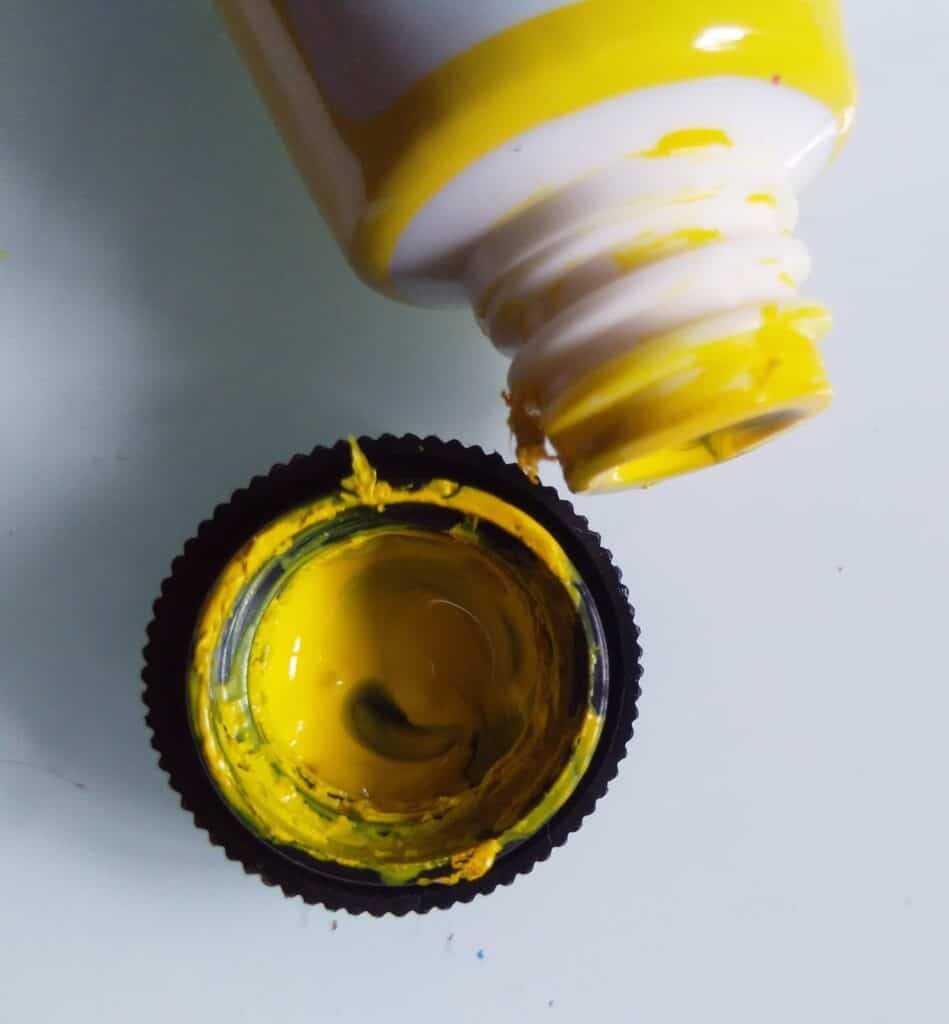
Also if the acrylic paint comes in a metal container, it is easy to damage it by flexing the tube too many times in the same spot. If the acrylic paint tube is old, the soft metals might be fragile and it will be easier to poke holes in the paint tube. These damages to the paint container will make a doorway for the moisture to escape from acrylic paint. It will make acrylic paint thicker and even dry out acrylic paint.
Old acrylic paint can become thick in consistency
You may have kept away acrylic paint that you do not need, maybe in your basement. The next time you checked on them may be months or years later, you will find that the acrylic paints are separated. You can recognize acrylic paint separation if there is a clear liquid sitting on top of acrylic paint solids.
Other than temperature fluctuations, separation can happen in acrylic paints that have been there without any movement for a long time, like in paints that have been sitting on the store shelves for a long time or the paint you kept in the basement.
To protect your acrylic paints from temperature fluctuations, one artist has suggested using styrofoam coolers which are inexpensive to store acrylic paints. This insulated cooler will help you keep acrylic paint with its original consistency for a long time. You can use this container for new unopened paints as well as they also can dry or separate.
What do you do if acrylic paint is too thick?
There are a few things you can do to thin down thick acrylic paints. One is mixing with a acrylic paint thinner. You can also stirre and mix well the acrylic paint if it is separated. Preventing acrylic paint from becoming thick is also important by maintaining proper environmental conditions and following good artistic practices. I have explained each of them below in detail.
Use acrylic paint thinners like water and acrylic mediums
If acrylic paint is too thick you can thin it with some water. Also, it is best to mix a little water with acrylic paint for smoother application or you can wet the brush and use it with acrylic paint. You can add more water depending on the consistency you want with acrylic paint.
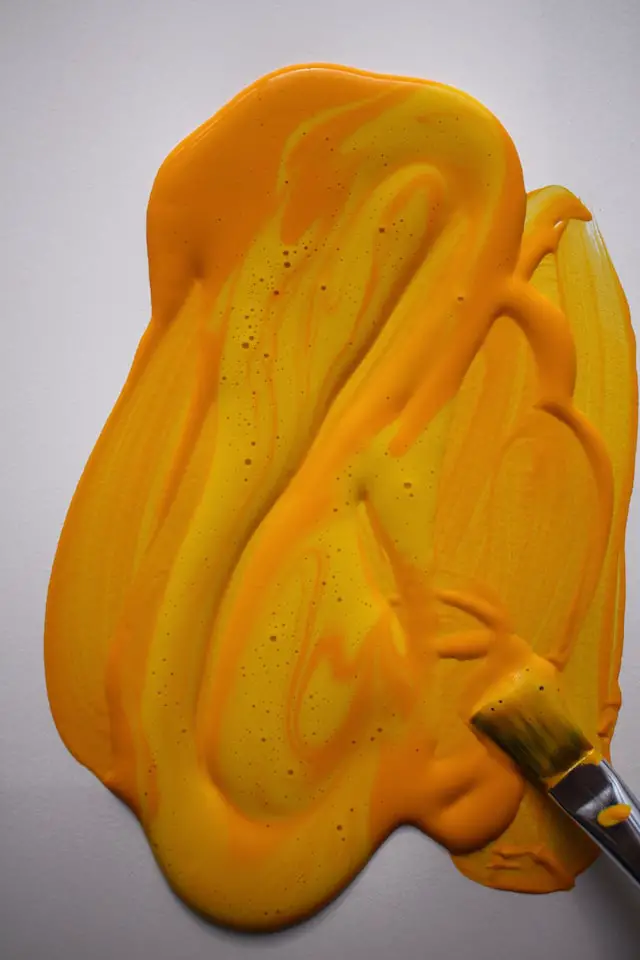
If you want to know more about using water with acrylic paint, you can read my article; Do you have to wet the brush before acrylic painting?
Other than water you can use acrylic mediums with acrylic paint. This is best if you do not want to thin the paint too much. To thin heavy body acrylic, you can use matte medium, gloss medium, and glazing mediums. These mediums are usually thinner and fluid.
But if you mix with thicker mediums like acrylic gel medium, slow dry mediums, impasto mediums, and pastes, acrylic paint will become thick instead of becoming thin. This is not the way to go unless you want an even thicker consistency.
You can use a palette knife to mix acrylic paint with acrylic medium. Take out the paint onto the palette and then mix it with a palette knife well until the paint become thin. If you like to know more about thinning acrylic paint and different ways of making it transparent you can read my article; 8 Easy ways how to make acrylic paint transparent.
Stire and mix separated or dried acrylic paint
If the acrylic paint is dry add a little water and mix really well preferably in a tub or a little jar. This will be harder to do in a paint tube and also mixing can damage the paint tube. In this case, take the paint out onto a clean surface and mix.
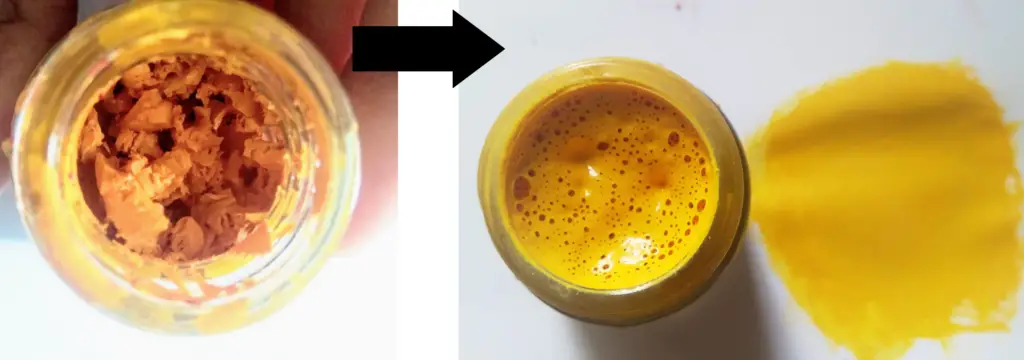
Mix the dried acrylic paint while gradually adding water drop by drop. Mix water and dried paint well before adding more water. Eventually, acrylic paint will become a more viscous liquid. But due to mixing there will be many paint bubbles that don’t matter.
You can read more about reactivating dried acrylic paint in my article; How to reactivate dried acrylic paint? (Is it possible?). However, if there is no moisture left in acrylic paint and it is completely dry there is no way of reviving that acrylic paint. In this case, it is best to through that acrylic paint away.
If you use Atelier interactive acrylic paint, it can be reactivated even after drying (touch to dry), but not after all the moisture left the paint film (cured).
If the acrylic paint is separated mix the separated clear liquid with acrylic paint solids well, using a stick or a palette knife. Most of the time separated acrylic paint can be mixed together without a problem, and you can use it just as fresh acrylic paint.
I have written a whole article about ‘How can you tell if acrylic paint is bad?‘. You can find the common signs of bad acrylic paint, and how to fix and prevent them in that article.
Maintain proper storage conditions and practices with acrylics
Storing acrylic paint in proper conditions is very important to prevent acrylic paint from drying and thickening up. Always try to store acrylic paint at an ambient temperature between 60-70°F (16-21°C). Do not subject acrylic paint to extreme cold or high temperatures as much as possible.
Talk to your paint manufacturer and know if it is okay to order acrylic paint in the winter and if the paint can tolerate freezing temperatures. Close the acrylic paint tubes properly. Make sure the lids are screwed well. Always clean the paint tube or tub openings and inside the lids after using.
To avoid temperature fluctuations you can use an insulated cooler. You can store both unopened and opened paints there. This will save your paints rather than storing them in an unheated storage unit.
Also, it is a good practice to reduce contaminations with acrylic paint. Because bacteria contaminations can make acrylic paint stringy. Therefore do not use palette knives or brushes in direct contact with your paint. Take your acrylic paint out of the containers and then start using it.
The bottom line
Acrylic paint might naturally be in thick consistency as with heavy body acrylic paint. But you can thin heavy body acrylics with either water or the right acrylic medium. However, if you buy acrylic paint that has been sitting on the shelves for a long time, you will notice that they are thicker than usual. In this case, also you can mix them with a little water or acrylic medium to thin down the paint.
If the paint is separated mix the separated clear liquid into the paint well. Do not through the clear liquid away as it is the acrylic polymer binder. If acrylic paint has started to dry, try mixing well with a little water first and gradually adding more water. If the dry acrylic paint has almost no water left or is cured, there is no way of reviving that acrylic paint; it is best to through that paint away.

